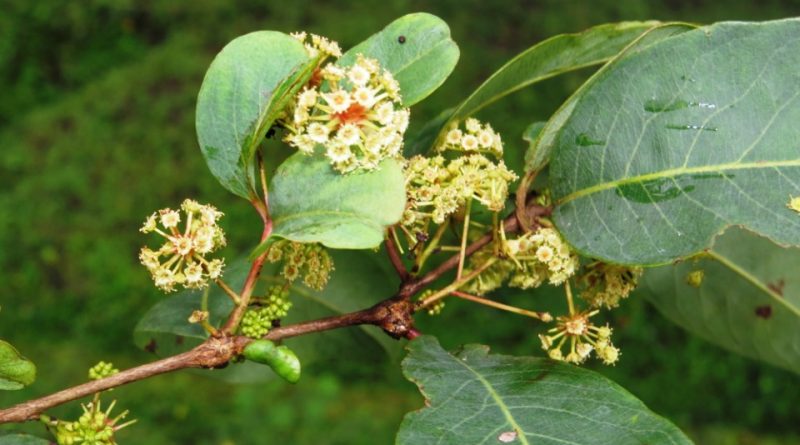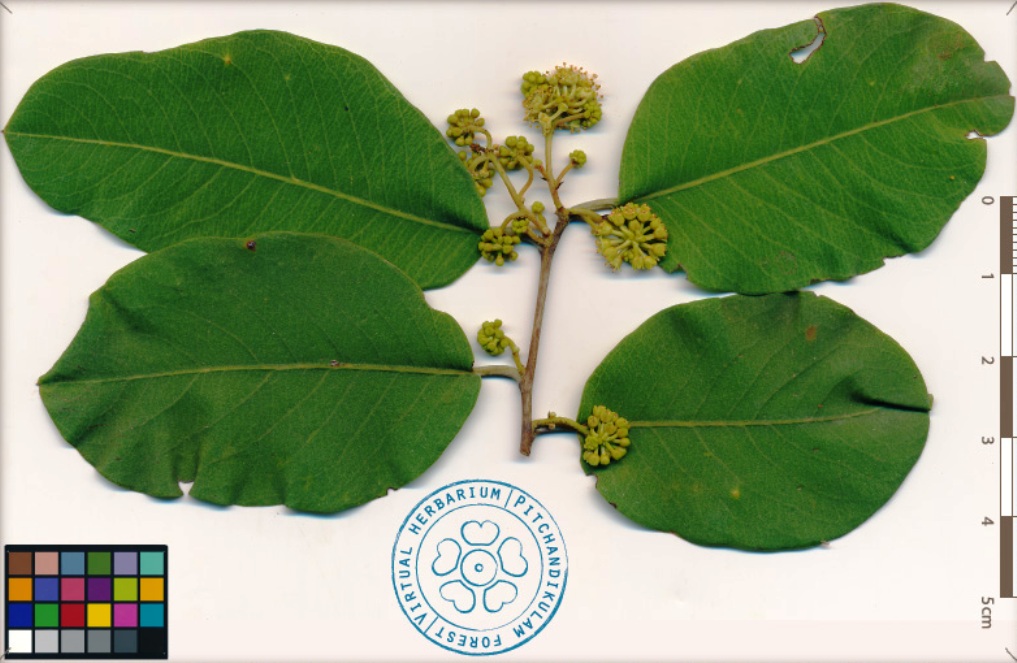Anogeissus latifolia
Anogeissus latifolia
The Axle wood (Anogeissus latifolia (Roxb. Ex DC.) Wall. Ex Guill. & Perr.) Is an arboreal species belonging to the Combretaceae family.
Systematic –
From a systematic point of view it belongs to the Eukaryota Domain, Kingdom Plantae, Subregion Tracheobionta, Division Magnoliophyta, Class Magnoliopsida, Subclass Rosidae, Order Myrtales, Family Combretaceae and therefore to the Genus Anogeissus and to the Species latifolia.
The terms are synonymous:
– Anogeissus latifolia var. hairless C.B.Clarke;
– Anogeissus latifolia var. tomentosa Haines;
– Anogeissus latifolia var. villosa C.B.Clarke;
– Conocarpus latifolius Roxb. ex DC ..
Etymology –
The term Anogeissus comes from the Greek anus, “upwards” and geisson “tile”, referring to the fruiting parts.
The specific epithet latifolia comes from latus largo, extended and from fólium leaf; therefore with broad leaves.
Geographical Distribution and Habitat –
Axle wood is a small tree native to India, Nepal, Myanmar and Sri Lanka.
Its habitat is quite large: it is found in the deciduous or semi-evergreen forest; it is a common element in teak forests, but it is also found in the Dipterocarpacee forests, in low-altitude tropical areas, in bamboo forests and even in vegetation in semi-arid conditions such as savannah forests and dry rocky hills, where it is found at altitudes up to 1,300 meters.
Description –
Anogeissus is a small and medium-sized deciduous tree that grows up to 20 meters and occasionally up to 35 meters.
The trunk can be unbranched up to 15 meters.
The leaves are ovate in shape, with an average size of 3 cm in width and 5 cm in length, with a more evident central rib and less perceptible lateral ribs.
The flowers are small, whitish – light green in color, gathered in small inflorescences.
The fruits are small and green in color.
Cultivation –
Axle wood is a plant in the driest plains of tropical wetlands, where it grows up to 1,300 meters.
This tree grows best in areas where annual daytime temperatures are between 22 and 33 ° C, but can tolerate between 7 and 47 ° C. Adult plants can die at temperatures of -2 ° C or lower, but the growth of young seedlings can be severely damaged at 0 ° C.
It is a plant that prefers an average annual rainfall in the range 800 – 1,400 mm, but tolerates intervals between 600 and 2,300 mm. In any case, the plants already well rooted are resistant to drought.
Young trees tolerate shade but adult trees require a sunny position.
From a pedological point of view, it grows better in a deep, fertile and well-drained soil, but it can also be successful in low fertility soils, however it prefers a pH in the range 5.5 – 6.5, tolerating 5 – 7.
The natural regeneration of this species is very good, although young trees are very intolerant to competition from weeds; however the plant produces root suckers, which tend to form coppices.
Where this plant is present, thinning the coppice is necessary for good governance; moreover, trees can be easily damaged by fire.
As far as seed propagation is concerned, the viability of these is low but increases after very dry seasons. Germination rates can be increased by immersing the seeds in hot water for 3 minutes.
Rooting through cuttings is more difficult.
Fruits should only be harvested when fully ripe since immature seeds fail to germinate. Ripe fruits are collected from the trees, dried in the sun and then preserved. Storage of seeds in metal cans or polythene containers is best.
The tree is often harvested for its rubber and tannins. It also produces good quality wood and the plant is used in soil stabilization programs.
Uses and Traditions –
This plant is known by the common names of axlewood (English), bakli, dhau, dhawa, dhawra or dhaora (hindi), takhian-nu (thai) and raam (vietnamese).
Anogeissus latifolia is one of the most useful trees in India. Its leaves contain large quantities of gallotannins, and are used in this country for tanning and the use of firewood.
The tree is the source of Indian gum, also known as ghatti gum, which is used, among other uses, for the printing of chalices.
The leaves represent the food for the Antheraea paphia moth which produces tassar silk (Tussah), a form of wild silk of commercial importance.
Anogeissus latifolia is one of the important medicinal plants in Ayurveda medicine for the treatment of heart ailments.
The plant is useful in some infections, in skin diseases, in liver disorders, in fever, in epileptic seizures, and has, among others, microbicide activities.
From an ecological point of view, its flowers are an important source of pollen for bees; in addition, the tree contributes to the cycle of soil nutrients, exhibiting high rates of decomposition of leaf waste.
Among other uses, it is recalled that in India this plant is used in the treatment of snake bites and scorpion stings.
From a food and pharmaceutical point of view, the ghatty gum obtained from wood exudates has a typical consistency of yellowish-white droplets, is soluble in water, giving a very sticky mucilage. This is a good substitute for gum arabic and is used for sweets, in the dyeing processes and as a binding agent in pharmaceutical products.
In addition, the leaves and bark are used to obtain tanning products.
The leaves produce a black dye which is used commercially in India.
Finally the wood. This is hard with a density of 760-940 kg / m3. The heartwood is absent or small; consistency from fine to medium and uniform. Shrinkage during seasoning is moderate to high and the wood is difficult to season since it is subject to deformation, cracks and surface control. It is possible to completely change the surface control by immersing in 50% polyethylene glycol-600 solutions for 1 day.
Wood is used to create fences in the fields and produces good coal and firewood with an energy value of 17,600-20,500 kJ / kg.
Method of Preparation –
The gum that oozes from the trunk, known as “ghatti gum”, has been used in sweets and as an emulsifier in the food industry.
Guido Bissanti
Sources
– Acta Plantarum – Flora of the Italian Regions.
– Wikipedia, the free encyclopedia.
– Treben M., 2000. Health from the Lord’s Pharmacy, Tips and experiences with medicinal herbs, Ennsthaler Editore
– Pignatti S., 1982. Flora of Italy, Edagricole, Bologna.
– Conti F., Abbate G., Alessandrini A., Blasi C. (edited by), 2005. An annotated checklist of the Italian vascular flora, Palombi Editore.
Warning: Pharmaceutical applications and alimurgical uses are indicated for information purposes only, they do not in any way represent a medical prescription; therefore, no responsibility is accepted for their use for healing, aesthetic or food purposes.


